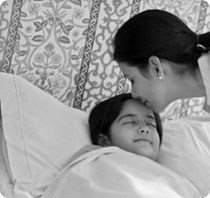

STEM CELL TRANSPLANT
Thalassaemia Major is caused by genetic mutations resulting in the reduced or non-production of Beta Chains. As a result globin synthesis does not take place resulting in premature destruction of Red Blood Cells.
Production of R.B.C.s takes place in the Bone Marrow. Unfortunately, the Bone Marrow of a Thalassaemia Major child produces R.B.C’s, which die prematurely. The permanent cure, therefore would involve the ability to produce RBCs.
Stem Cells are the parent bone marrow cells of the human body. They have the ability to become different types of blood cells like RBCs, WBCs and Platelets. They are typically found in three places:
- Bone Marrow
- The Blood Stream
- Cord Blood
Transplant of stem cells from a donor to a Thalassaemia Major patient can offer a permanent cure. This transplant will be possible if the HLA (Human Leucocyte Antigen) type of the donor matches that of the recepient. One option is to search for an ‘HLA-matched’ donor from within the family. But in more than 70% of the cases this may not yield a match. It is therefore necessary to look at unrelated donors too. This will be facilitated if a registry is prepared of willing donors, whose HLA typing has been done. The chances of finding a matching donor will be higher if the donor belongs to the same ethnic group. Unfortunately patients in India have to depend on American and European Stem Cell registries, as India does not yet have a functional registry.
Stem Cells Trasplantation can be effected by:
- Bone Marrow Transplant
Bone Marrow is the spongy substance which is found inside the hollow bones of the body, and contains stem cells. The Bone Marrow donor will have to undergo a procedure in sterile conditions in a hospital. Under general anaesthesia, the bone marrow is aspirated from the back of the hip bone of the donor in the procedure which may atke up to 2 hours. The donor’s marrow is replenished within 6 weeks. - Peripheral Blood Stem Cell Transplant
In this procedure the donor is given injections of a growth factor for four to five consecutive days. This facilitates mobilization of stem cells from the bone marrow into the blood stream. The donor is then required to go through a process of ‘Apheresis’, which will draw blood through a vein, pass the blood through the Apheresis Machine for separation of Stem Cells, and return the remaining components to the donor. This cycle is repeated, and the entire procedure will take between 3 to 4 hours. If enough stem cells are not collected during this procedure a repetition will be required. - Cord Blood Transplant
Cord Blood is placental blood which is collected during child birth. This cord blood, which is very rich in stem cells, is collected and stored for future use. Therefore there is no question of looking for a donor. The risk of Graft Versus Host Disease (GVHD), which exists in other Stem Cells Transplants, is much lesser in the case of Cord Blood.
Apart from the hurdle of finding a matching donor, Stem Cell Transplant also has to contend with a huge financial cost as well as careful and extended post-operative care. These hurdles put the option of stem cell transplant outside the reach of most Indian patients.
Stem Cell Registry
HLA-matched Stem Cells can offer a cure to thalassaemia major patients. Leukemia patients also can look forward to Stem Cells Transplant as a life saving procedure. However, it is important that the HLA factors of the patient and the donor are found to match. Relatives and close friends of patients in India today form the core registry from which to identify HLA-matched donors. This is because there exists no registry of Stem cell Donors in India. Less than 30% of the patients may find a donors from this pool. The European and American registries offer only a very, very slim chance of finding an HLA-matched donor. It is easier to find a match from a pool consisting of people from the same ethnic group.
The Bone Marrow Registry of India (BMRI) has been established with the objective of preparing and maintaining a centralized and confidential HLA typed database of potential voluntary donors of Indian ethnic background. The BMRI will be networked with other registries, thereby providing access to donors all over the world.
You could get in touch with Think Foundation if you desire to be a Stem Cell Donor, or if you would like to have an awareness session on Stem Cell Transplant in your institution.
Blood
Platelets
Blood Drive
Thal Minor
Thal Minor Screening Drive
Platelet Donor
Donate Blood
